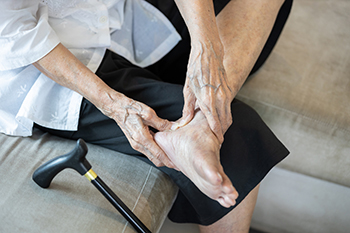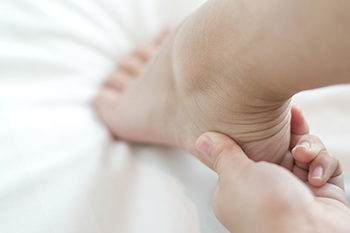Items filtered by date: August 2025
Foot Problems in Older Adults May Signal Frailty

As people age, foot problems can become more common and may signal broader issues related to frailty. Thickened toenails, bunions, loss of cushioning, and poor circulation can lead to discomfort, instability, and reduced activity. These issues are not just a nuisance, they may contribute to falls, loss of independence, and slower recovery from illness or injury. In some cases, pain or deformities in the feet can lead to an uneven gait, making daily movement more difficult. Skin changes, decreased muscle strength, and balance issues often appear alongside these foot concerns. Addressing foot health early can improve mobility and overall well-being. If you or someone you care for is experiencing new or worsening foot problems, it is suggested that you consult a podiatrist to help maintain comfort, stability, and quality of life.
If you need your feet checked, contact Mindy J. Trotter, DPM, CWSP of Georgia. Our doctor will attend to all of your foot and ankle needs and provide you with quality treatment.
Geriatrics and Podiatry
When people age, some common issues that may occur are bone density loss, dry skin, poor circulation, and rough brittle nails. These issues may also affect your foot health if the necessary steps are not taken to alleviate the problems.
It is important to take care of your feet because feet that are injured or diseased can affect your overall health. Having painful feet hinders your ability to do daily activities or may decrease your willingness to do the things that you need to do.
Visiting Your Geriatrician
As we age, health problems become more likely, so it is essential to visit your doctor for check-ups to ensure that you are doing the best you can to take care of your health. It is recommended to check your feet frequently for any possible cuts, bruises, swelling, corns or any other irregularities.
Taking Care of Elderly Feet
Cracked or dry feet can be treated by applying moisturizer often. It is also important not to wear old socks because the older the sock is, the higher the possibility there will be that there is bacteria there. Wear fresh socks and make sure they fit properly.
Proper foot health means that you can have a more active lifestyle and you will not be bogged down by pain. Foot health also leads to good circulation, which is paramount for overall health.
If you have any questions, please feel free to contact our office located in Peachtree City and Newnan, GA . We offer the newest diagnostic tools and technology to treat your foot and ankle needs.
What Parents Should Know About Heel Pain in Kids

Sever’s disease is a common cause of heel pain in active children, especially those aged 8 to 14. It occurs when the growth plate in the heel becomes inflamed due to repetitive stress from activities like running or jumping. Symptoms include heel pain that worsens with activity, limping, and tenderness at the back or bottom of the heel. The heel may appear swollen or sensitive to touch, and children might avoid putting full weight on the foot. Treatment focuses on reducing inflammation and relieving pressure on the heel. A podiatrist can recommend stretching exercises and supportive footwear or custom orthotics to cushion the heel. In some cases, targeted exercises may be needed to improve flexibility and strength. Early care helps children stay active and prevents long-term problems. If your child is dealing with this issue, it is suggested that you make an appointment with a podiatrist.
Sever's disease often occurs in children and teens. If your child is experiencing foot or ankle pain, see Mindy J. Trotter, DPM, CWSP from Georgia. Our doctor can treat your child’s foot and ankle needs.
Sever’s Disease
Sever’s disease is also known as calcaneal apophysitis, which is a medical condition that causes heel pain I none or both feet. The disease is known to affect children between the ages of 8 and 14.
Sever’s disease occurs when part of the child’s heel known as the growth plate (calcaneal epiphysis) is attached to the Achilles tendon. This area can suffer injury when the muscles and tendons of the growing foot do not keep pace with bone growth. Therefore, the constant pain which one experiences at the back of the heel will make the child unable to put any weight on the heel. The child is then forced to walk on their toes.
Symptoms
Acute pain – Pain associated with Sever’s disease is usually felt in the heel when the child engages in physical activity such as walking, jumping and or running.
Highly active – Children who are very active are among the most susceptible in experiencing Sever’s disease, because of the stress and tension placed on their feet.
If you have any questions, please feel free to contact our office located in Peachtree City and Newnan, GA . We offer the newest diagnostic and treatment technologies for all your foot and ankle injuries.
